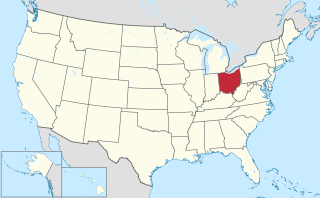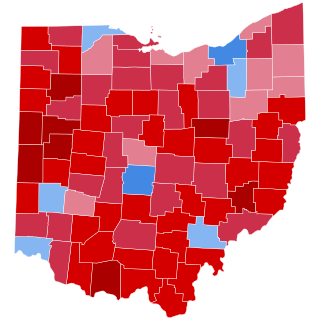This article needs additional citations for verification .(February 2013) |
| Year | Republican / Whig | Democratic | Third party | |||
|---|---|---|---|---|---|---|
| No. | % | No. | % | No. | % | |
| 2020 | 3,154,834 | 53.18% | 2,679,165 | 45.16% | 98,447 | 1.66% |
| 2016 | 2,841,006 | 51.31% | 2,394,169 | 43.24% | 301,372 | 5.44% |
| 2012 | 2,661,437 | 47.60% | 2,827,709 | 50.58% | 101,788 | 1.82% |
| 2008 | 2,677,820 | 46.80% | 2,940,044 | 51.38% | 103,967 | 1.82% |
| 2004 | 2,859,768 | 50.81% | 2,741,167 | 48.71% | 26,973 | 0.48% |
| 2000 | 2,351,209 | 49.97% | 2,186,190 | 46.46% | 168,058 | 3.57% |
| 1996 | 1,859,883 | 41.02% | 2,148,222 | 47.38% | 526,329 | 11.61% |
| 1992 | 1,894,310 | 38.35% | 1,984,942 | 40.18% | 1,060,712 | 21.47% |
| 1988 | 2,416,549 | 55.00% | 1,939,629 | 44.15% | 37,521 | 0.85% |
| 1984 | 2,678,560 | 58.90% | 1,825,440 | 40.14% | 43,619 | 0.96% |
| 1980 | 2,206,545 | 51.51% | 1,752,414 | 40.91% | 324,644 | 7.58% |
| 1976 | 2,000,505 | 48.65% | 2,011,621 | 48.92% | 99,747 | 2.43% |
| 1972 | 2,441,827 | 59.63% | 1,558,889 | 38.07% | 94,071 | 2.30% |
| 1968 | 1,791,014 | 45.23% | 1,700,586 | 42.95% | 468,098 | 11.82% |
| 1964 | 1,470,865 | 37.06% | 2,498,331 | 62.94% | 0 | 0.00% |
| 1960 | 2,217,611 | 53.28% | 1,944,248 | 46.72% | 0 | 0.00% |
| 1956 | 2,262,610 | 61.11% | 1,439,655 | 38.89% | 0 | 0.00% |
| 1952 | 2,100,391 | 56.76% | 1,600,367 | 43.24% | 0 | 0.00% |
| 1948 | 1,445,684 | 49.24% | 1,452,791 | 49.48% | 37,596 | 1.28% |
| 1944 | 1,582,293 | 50.18% | 1,570,763 | 49.82% | 0 | 0.00% |
| 1940 | 1,586,773 | 47.80% | 1,733,139 | 52.20% | 0 | 0.00% |
| 1936 | 1,127,855 | 37.44% | 1,747,140 | 57.99% | 137,594 | 4.57% |
| 1932 | 1,227,319 | 47.03% | 1,301,695 | 49.88% | 80,714 | 3.09% |
| 1928 | 1,627,546 | 64.89% | 864,210 | 34.45% | 16,590 | 0.66% |
| 1924 | 1,176,130 | 58.33% | 477,888 | 23.70% | 362,219 | 17.97% |
| 1920 | 1,182,022 | 58.47% | 780,037 | 38.58% | 59,594 | 2.95% |
| 1916 | 514,753 | 44.18% | 604,161 | 51.86% | 46,172 | 3.96% |
| 1912 | 278,168 | 26.82% | 424,834 | 40.96% | 334,092 | 32.21% |
| 1908 | 572,312 | 51.03% | 502,721 | 44.82% | 46,519 | 4.15% |
| 1904 | 600,095 | 59.75% | 344,674 | 34.32% | 59,624 | 5.94% |
| 1900 | 543,918 | 52.30% | 474,882 | 45.66% | 21,273 | 2.05% |
| 1896 | 525,991 | 51.86% | 477,497 | 47.08% | 10,807 | 1.07% |
| 1892 | 405,187 | 47.66% | 404,115 | 47.53% | 40,862 | 4.81% |
| 1888 | 416,054 | 49.51% | 396,455 | 47.18% | 27,852 | 3.31% |
| 1884 | 400,082 | 50.99% | 368,280 | 46.94% | 16,248 | 2.07% |
| 1880 | 375,048 | 51.73% | 340,821 | 47.01% | 9,098 | 1.25% |
| 1876 | 330,698 | 50.21% | 323,182 | 49.07% | 4,769 | 0.72% |
| 1872 | 281,852 | 53.24% | 244,321 | 46.15% | 3,263 | 0.62% |
| 1868 | 280,167 | 54.00% | 238,621 | 46.00% | 0 | 0.00% |
| 1864 | 265,654 | 56.37% | 205,599 | 43.63% | 0 | 0.00% |
| 1860 | 221,809 | 51.24% | 187,421 | 43.30% | 23,632 | 5.46% |
| 1856 | 187,497 | 48.51% | 170,874 | 44.21% | 28,126 | 7.28% |
| 1852 | 152,523 | 43.18% | 168,933 | 47.83% | 31,732 | 8.98% |
| 1848 | 138,359 | 42.12% | 154,773 | 47.12% | 35,347 | 10.76% |
| 1844 | 155,113 | 49.68% | 149,061 | 47.74% | 8,050 | 2.58% |
| 1840 | 148,157 | 54.10% | 124,782 | 45.57% | 903 | 0.33% |
| 1836 | 104,958 | 51.87% | 96,238 | 47.56% | 1,137 | 0.56% |
Political control of Ohio has oscillated between the two major parties. Republicans outnumber Democrats in Ohio government. The governor, Mike DeWine, is a Republican, as are all other non-judicial statewide elected officials: Lieutenant Governor of Ohio Jon A. Husted, Ohio Attorney General Dave Yost, Ohio State Auditor Keith Faber, Ohio Secretary of State Frank LaRose and Ohio State Treasurer Robert Sprague.
Contents
In the Ohio State Senate, the Republicans have a supermajority (26-7), and in the Ohio House of Representatives the Republicans also have a supermajority delegation (66-32), and they have generally held the legislature since the latter half of the 20th century. The Ohio Congressional Delegation is mostly Republican as well; 10 representatives are Republicans while five are Democrats. One U.S. senator, J. D. Vance, is a Republican, while the other, Sherrod Brown, is a Democrat.
The mayors of most of the 10 largest cities in the state (Columbus, Cleveland, Cincinnati, Toledo, Akron, Dayton, Youngstown, Canton, Parma, Lorain) are Democrats. The Republicans are strongest in the rural Northwest, the affluent Cincinnati and Columbus suburbs, and have made gains in Appalachian Southeast Ohio and the industrial, working-class Northeast in the 21st century. The Democrats rely on the state's major cities, and have made gains in educated suburban areas in recent years.
The state was strongly Republican from the party's inception, voting Republican in every election from 1856 to 1908. The northern Union-aligned part of the state kept the state Republican, and consistently narrowly edged out the Democratic and Appalachia-influenced southern Ohio. Since 1896, however, Ohio has voted for the winning candidate, except for Franklin D Roosevelt in 1944, John F Kennedy in 1960, and Joe Biden in 2020. This was due to Democratic gains in the northeastern part of the state. The state has not backed a losing candidate in consecutive elections since 1848. Due to a close split in party registration, it has been a key battleground state. No Republican has ever been elected president without winning Ohio. In 2004, Ohio was the tipping point state, as Bush won the state with 51% of the vote, giving him its 20 electoral votes and the margin he needed in the Electoral College for re-election. The state was closely contested in 2008 and 2012, with Barack Obama winning narrowly on both occasions. Ohio has been a bellwether state in presidential elections.
Since 2016, Ohio's bellwether status has been questioned given that Donald Trump won it by 8 points, the largest margin for each party since 1988, and then won the state by a similar margin in 2020 despite losing nationwide. [2] [3]
Additionally, Ohio's presidential electoral vote total has been declining for decades. Ohio lost two electoral votes after the results of the 2010 United States Census, leaving it with 18 electoral votes for the presidential elections in 2012, 2016, and 2020. The number of electoral votes was down from 20 in the 2004 and 2008 elections, and down from a peak of 26 in 1964 and 1968. As of 2020, Ohio has its fewest electoral votes since 1828, when it cast 16. The state cast 3.71 percent of all electoral votes from 2004 through 2020, the smallest percentage since it cast 3.40 percent of the votes in 1820.
Ohio's large population has long made the state a major influence in politics. Seven presidents have been from Ohio, all Republicans: William Henry Harrison, Ulysses S. Grant, Rutherford B. Hayes, James A. Garfield, William McKinley, William Howard Taft and Warren G. Harding. [4]













